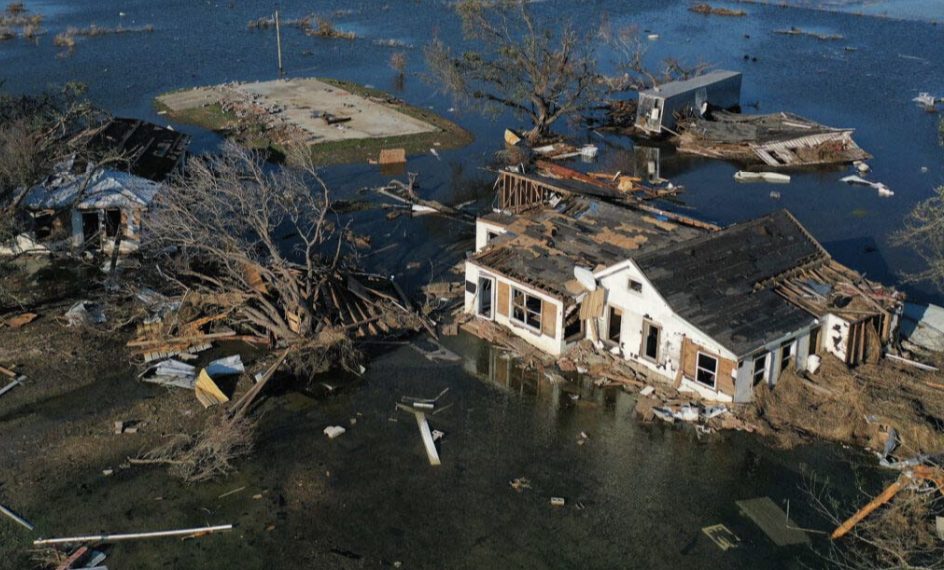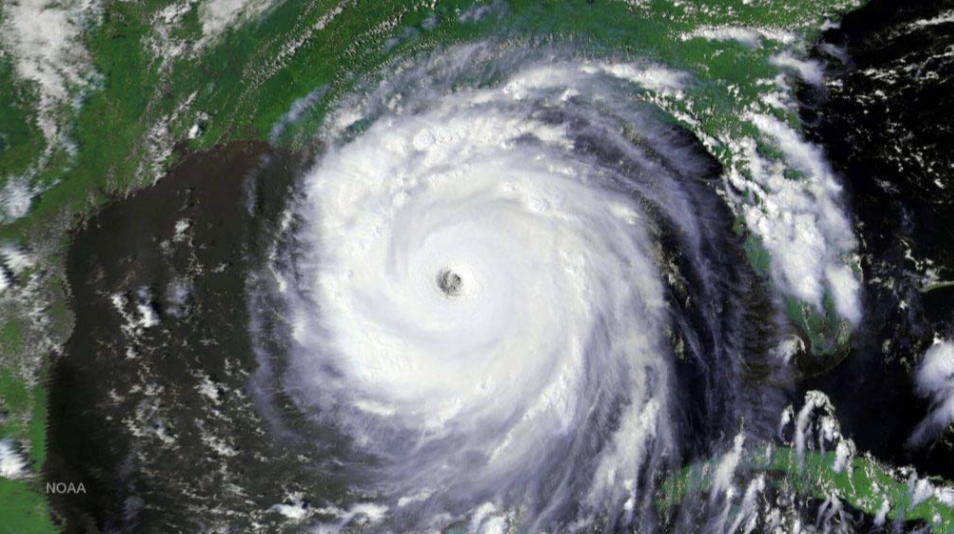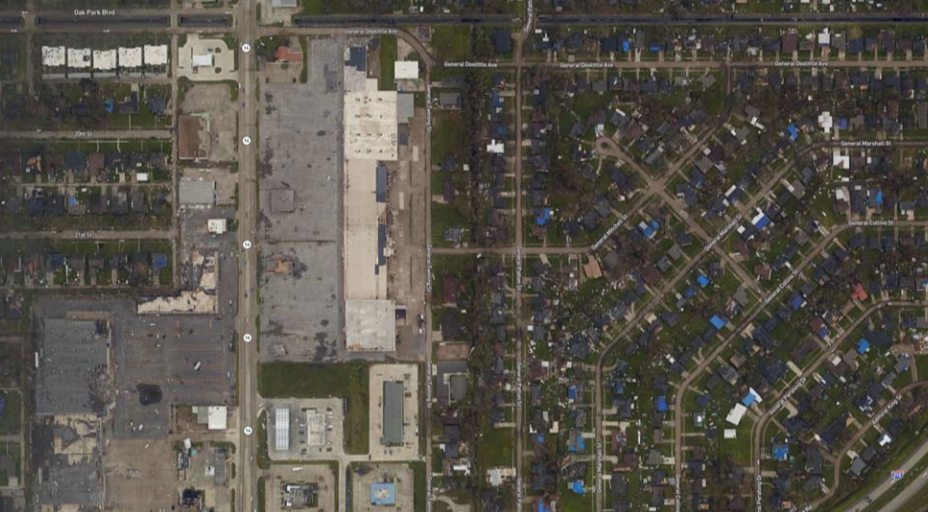Of 2020’s Atlantic storms, 13 were hurricanes, six of them Category 3 or higher. Warmer ocean waters are fueling an increasing number of storms.
The Climate News, December 24, 2020

By James Bruggers, Bob Berwyn
For Darilyn Turner and her neighbors, living in the bottomlands along the banks of the Mississippi River south of New Orleans is particularly perilous from June through November.
Those months encompass the Atlantic hurricane season. Even in a normal year, people are on edge, she said, worried about storms that blow over the Gulf of Mexico, bringing walls of water, high winds and, often, widespread destruction when they find land.
But 2020 was no normal year.
A record Atlantic basin hurricane season was fueled by warmer than normal ocean and Gulf waters that scientists say were, at least in part, caused by climate change. In all, there were 30 named storms, the most on record and almost three times the typical number. The basin includes the Atlantic Ocean, Caribbean Sea and Gulf of Mexico.
Thirteen of those became hurricanes, and six were major hurricanes, Category 3 or higher, according to the National Oceanic and Atmospheric Administration. That compares to the long-term average of 12 named storms, with six of them hurricanes and three of them majors.
Central America, the Gulf Coast and the state of Louisiana were especially hard hit, with the storms taking a major toll on low-income and Black and brown communities. The 2020 storms were made worse by a global pandemic that had killed nearly 315,000 Americans, including more than 7,000 Louisiana residents, as of Dec. 20.
Five storms—three hurricanes and two tropical storms—struck Louisiana alone, setting a seasonal record for that state. Hurricane Laura was a Category 4 when it made landfall near Cameron, Louisiana, on Aug. 27.
Laura was the strongest hurricane, when measured by wind speed, to strike Louisiana in 150 years, its 150 mph winds causing 28 deaths and at least $12 billion in economic damage.
By comparison, Hurricane Katrina, in 2005, was a Category 3 storm when it made landfall, with sustained winds of 120 mph. Unlike Laura, Katrina was a major flood event, with failing levees that resulted in floodwaters covering about 80 percent of New Orleans, according to NOAA.
The five storms that his Louisiana this year left behind battered lives and shattered nerves.
“We had to evacuate for several potential threats to lower Plaquemines Parish,” said Turner, who runs the Zion Travelers Cooperative Center there. It’s a nonprofit faith-based community development corporation organized in the aftermath of Katrina’s devastation.
One of the 2020 hurricanes, Zeta, directly struck her community, damaging homes and sheds, Turner said, and leaving people without much money “trying to figure out where to go from here.
“Your stress level is through the roof. Everybody in my community has some danger.”
A Hyperactive Season
The 2020 spike in hurricane activity wasn’t surprising to Kevin Trenberth, an atmospheric scientist based in New Zealand.
“In general, one expects more activity as the climate warms,” he said. “This can be manifested in multiple ways: more intense storms, bigger storms, longer-lasting storms, and more storms. Also in general there is increased risk of flooding.”

All that can be traced to the increasing warmth of the oceans. They’ve warmed by about 1 degree Fahrenheit in the past 100 years, and not just at the surface.
Trenberth said that, in decades past, hurricanes stirred up a cold wake of water that helped inhibit formation of subsequent storms. But with oceans now warming at depth, even the churned water from below is much warmer than it was.
Oceans warm earlier, allowing storms to form before the official season begins, as happened with Tropical Storms Arthur and Bertha in May. Oceans also hold heat later into the year, a likely factor in the formation of Hurricanes Eta and Iota in November.
In a pattern common to other recent storms thought to be linked with global warming, Eta and Iota intensified rapidly near the coast of Central America, killing more than 270 people and causing about $9 billion in damage.
Hardest hit were Nicaragua, Honduras and Guatemala, where rains, floods and mudslides disrupted the lives of more than 6 million people. The storms wiped out livestock and harvests and destroyed tourist destinations in a region already struggling with the pandemic, according to the International Federation of the Red Cross.
The two storms “truly highlight the environmental injustice of the people who contributed the least to global warming but who experience the worst impacts,” said Rosanne Martyr, a climate scientist with Climate Analytics, an international think tank, who focuses on coastal vulnerability and adaptation.
“Islands in the Caribbean were also devastated, and they were still reeling from the previous seasons,” she said. “Some of these storms are much larger than anticipated when they hit land.”
The hyperactive 2020 Atlantic season marked the fifth straight year of above-average hurricane activity, and Martyr said she was particularly concerned about tropical storms starting to form earlier, before the official hurricane season. That shortens the time to recover from the previous seasons’ impacts, she said.
“What we really can do is mitigate climate change by cutting greenhouse gases,” she said. “We have to increase our ambition to help the countries that are being impacted the most. And we also have to up our ambition on adaptation. We have to figure out how to finance this to distribute resources in a way that’s fair and equitable and just.”
Martyr studies cost-effective, nature-based strategies to stem river flooding and storm surges associated with hurricanes.
For countries in Central America and the Caribbean, that means keeping coral reefs healthy, because they buffer storm energy, as well as giving coastal mangroves room to spread between the edge of the sea and towns or farming areas. Mangroves can absorb peak flood waters and release them slowly, which can protect communities and fields.
“Mangroves have the opportunity to migrate with sea level rise, but we need to provide that space for them to migrate inland,” Martyr said.
But with higher levels of warming, nature-based approaches could become infeasible. “You could take them off the table completely,” if global warming isn’t stopped, she added.
Climate extremes are increasing at the national and global level. Worldwide in the last 10 years, climate-related extreme weather, mainly heat waves and storms, killed more than 410,000 people, mostly in lower and middle-income countries. And in 2020, more than 50 million people were hit by climate-related disasters and the Covid-19 pandemic at the same time, according to a new report from the International Federation of Red Cross and Red Crescent Societies.
There is “a general realization that we are facing a more challenging reality,” said Maarten van Aalst, director of the International Red Cross and Red Crescent Climate Centre, which connects climate science with emergency response.

This year, hurricanes and tropical storms seemed to be everywhere. In late August, two were poised to strike the Gulf of Mexico within a few days of each other. A few weeks later, there were five tropical systems spinning in the Atlantic simultaneously, and in early September, Tropical Typhoon Haishen strafed Japan and Korea, as Hurricane Paulette aimed for Bermuda.
There was “a pattern around the world of repeated storms, happening at the same time in different places that gave us the feeling that this is our new reality,” von Aalst said.
A One-Two Punch
In all, five hurricanes and four tropical storms made landfall along the Gulf Coast, from Texas to Florida.
The Lake Charles, Louisiana, area was especially devastated by Hurricanes Laura and Delta, coming six weeks apart.

The hurricanes struck a region with high levels of racial segregation, poverty and unemployment, as well as some of the highest levels of toxic industrial emissions in the country, according a new report from The Lancet Countdown, an international research collaboration.
Just last month, a team from the University of Texas Medical Branch published a multi-year study in the Journal of the National Cancer Institute, which found that living in proximity to an oil refinery was associated with an increased risk of multiple types of cancer.
This year’s hurricanes added to that burden.
When hurricanes churn through a petrochemical hub, with a network of off-shore oil rigs, pipelines, storage tanks, refineries and chemical plants, as there is between Houston and New Orleans, they become pollution events.
To prepare for storms, industrial facilities will release pollutants as part of a shutdown process, and there can also be leaks and spills during the storms themselves.
An Environmental Defense Fund survey found that dozens of sites in Louisiana released pollutants after Hurricane Laura began threatening the state, though the impact of the pollution wasn’t clear because industry reports were incomplete. In Texas, facilities released more than 4 million pounds of extra air pollution because of shutdowns and related malfunctions in the days before Laura made landfall, the environmental group found.
“There is the underlying threat of Covid infections coupled with these intermittent and now seemingly regular hurricanes that are devastating their communities,” said Elena Craft, a Texas-based senior health scientist at Environmental Defense Fund.
“Apart from all the physical stress, wondering what is in the air you are breathing, and the financial stress, there’s the impact on mental health that these events might bring,” she said. “You add it up, on top of a pandemic, it’s no wonder these communities are not thriving.”
Hurricanes as Pollution Events
The most dramatic industrial release in Louisiana came when the BioLab chemical plant just outside of Lake Charles caught fire, and sent a cloud of chlorine gas and other pollutants into the air. Residents were told to stay inside, close windows and doors and turn off air conditioning, despite a heat wave with a heat index of up to 110 degrees.
Delma and Christine Bennett, longtime environmental justice advocates, have a home in Mossville near the BioLab plant. They evacuated for Laura, but when they returned, firefighters were still there.
“They were putting water on it, trying to contain it,” Delma Bennett said of the fire. “A lot of people weren’t exactly sure of what was happening. My wife got headaches.”
In comparison to past storms of similar size and strength, less pollution was released by petrochemical plants during the three hurricanes that made landfall in Louisiana in 2020, said Greg Langley, a spokesman for the Louisiana Department of Environmental Quality.
He added, “Industry made good preparations and weathered the storms well.”
Louisiana Gov. John Bel Edwards announced new coastal protection priorities in February to help shield the state and its most economically vulnerable communities from extreme weather.
The Times-Picayune and New Orleans Advocate reported that the initiative marked the first time Louisiana had targeted heat-trapping gas emission by Louisiana industry to help reduce future sea-level rise. In August, Bel Edwards signed an executive order, putting the state and its huge oil and gas sector on a path to net-zero carbon emissions.
“In many ways, Louisiana is the poster child for climate change, we are the canary in the coal mine,” Bel Edwards said in an Associated Press report.
Falling Through the Cracks
While the Federal Emergency Management Agency provides assistance to victims of hurricanes, people can fall through the cracks. In some places, Black-led organizations are trying to ensure a greater and more equitable level of service.
Liz Russell, climate justice program director with the Foundation for Louisiana, said many residents don’t have credit to start financing repairs while waiting for reimbursements from disaster relief funds.
And some people cannot get help because their homes may be owned by multiple family members with no clear title, she said.
There are also limits on home repair assistance.
“Some homes don’t get repaired for a long time,” Russell said.
In New Orleans, Imagine Water Works, a nonprofit focused on climate justice, water management and disaster response, has connected people in need with professionals and nonprofits who could provide help.
Thousands of southwest Louisiana residents who sheltered in hotels in New Orleans this year found themselves needing everything from face masks to haircuts, to cooking supplies, said Miriam S. Belblidia, co-founder and director of research and advocacy for Imagine Water Works.
“It continues to be a challenge,” she said. “There are still about 2,000 people sheltered here.”
Hilton Kelley, a longtime environmental justice advocate in Port Arthur, Texas, and director of the Community In-Power and Development Association, said that along the Gulf of Mexico, between Texas and Louisiana, “there are thousands of people as we speak without a place to live, and many people are still living in their homes but with damage to their roofs that is almost beyond repair.”
National media covered the hurricanes when they happened during this record-breaking year, he said, but quickly turned their attention elsewhere.
The hurricanes “just drain you,” he said. “You don’t know what else to do. You feel alone and abandoned.”
James Bruggers
Reporter, Southeast, National Environment Reporting Network
James Bruggers covers the U.S. Southeast, part of ICN’s National Environment Reporting Network. He previously covered energy and the environment for Louisville’s Courier Journal, where he worked as a correspondent for USA Today and was a member of the USA Today Network environment team. Before moving to Kentucky in 1999, Bruggers worked as a journalist in Montana, Alaska, Washington and California. Bruggers’ work has won numerous recognitions, including best beat reporting, Society of Environmental Journalists, and the National Press Foundation’s Thomas Stokes Award for energy reporting. He served on the board of directors of the SEJ for 13 years, including two years as president. He lives in Louisville with his wife, Christine Bruggers.